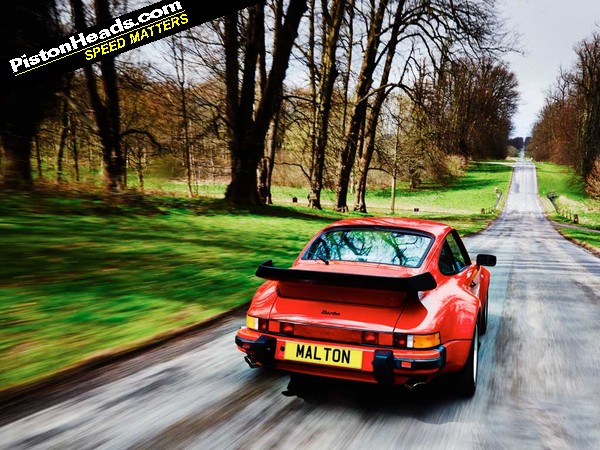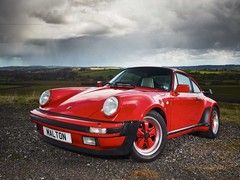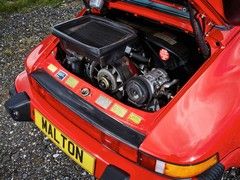Porsche 911 Turbo (930): Driven
The classic, 80s spec 911 Turbo, revisited. Why? Because it was rude not to.

It has been said that it's pretty astonishing that the 911 Turbo ever got built: in the mid 1970s, Germany was in recession as the wider world was reeling from the 1973 oil crisis and the subsequent stock market crash. Hardly conducive to the launch of an opulent, exclusive supercar. There was even strong opposition on the Porsche board, but Ernst Fuhrmann refused to let the Turbo project die. Thankfully.
In the metal
This lovely Guards Red 930 Turbo is a late 1980s model. 1988 to be specific, meaning I'd have been 10 when it was made and that it misses out on the G50 five-speed transmission. Its 3.3-litre blown six gives 300hp in a car weighing 1,300kg. The official figures say 0-60 in a whisker over five seconds. Top speed just the other side of 160mph. Not that far above hot hatch territory these days, but at the time, pretty epic. The shape, clumsy impact bumpers aside, is wonderful. Curvy, muscular, pure. Gorgeous Fuchs wheels and set off by the mother of all rear spoilers to let you know that this one was the boss.
The cabin feels light and surprisingly spacious. There's plenty of legroom, even for powerfully built six-footers, and you sit quite upright, with a commanding view over one of the most iconic vistas in motoring, enhanced as you check the door mirror and see the fat curve of the rear arch and a slab of tea tray rear wing.
The car fires instantly and settles into a relatively muted idle with just a hint of bassline throb. The dinky steering wheel is just where you want it, the pedals barely offset. OK, the seemingly random placing of minor switchgear leaves a lot to be desired but, hey, it's all part of the charm.
Muscle car
There is always some surprise at the heft required to manoeuvre at low speeds. Chunky rubber and no power assistance on the steering equates to a brief forearm workout until up and running.
Pottering in the Turbo is a doddle. But leaves you wondering where the power has gone. Off boost performance is modest and when you consider that covers the first 50 per cent of the rev range, you could spend a lot of time feeling short-changed. It is also very weird driving a car with precisely half the gears of a new BMW 5 Series.
So you need to pay attention to the rev counter, made easier by it taking pride of place directly in front of you in the constellation of VDO dials (and bright red in this machine to match the bodywork - not standard issue, I hasten to add).
Below 3K there is naff all, by three and a half you can feel the storm building and the boost gauge at the bottom of the rev counter is swinging in to life. By 4,000rpm the KKK 'charger is boosting at 0.8 bar and the acceleration goes ballistic.
Still got it
Don't be tempted to shift up early - do so under 6,000rpm and you risk dropping back out of the power band. Be brave, use the whole of the tacho before grabbing the next cog and the acceleration is seamless and potent. Of course a current Turbo would blow it into the weeds but make no mistake: even in 2013, this feels like a very fast car indeed.
As a hot-hatch driving kid, the preferred method of hooning generally centred around chucking one's underpowered shopping cart into corners as aggressively as possible in the effort to create excitement and/or oversteer. That is not a technique I'd particularly recommend when piloting somebody else's 930 Turbo and it's fair to say later years driving 911s has had a big influence on my driving style.
Get your braking done early, feed the car and power into the apex smoothly and hook up those massive rear boots you can feel the car sit and grip. As you accelerate traction increases still further as you apply more power, sitting the car even harder onto its rear tyres.
Junk in the trunk
As the nose lightens the wheel chirps and chatters to you over the texture of the road surface in a truly unique way. The volume and clarity of information being relayed from tarmac to fingertip is remarkable and an integral part of the experience.
As is that whiff of danger that always hangs over any older 911. Stir in the laggy delivery and the sheer on-boost thrust and you can understand how the Turbo might have punished the unwary or overambitious. Keep it smooth and unless you brake too deep or spool the turbo up suddenly mid-corner, you are unlikely to have problems.
After driving too many too big modern machines, the compact dimensions of the 930 are a delight. As mentioned earlier, you don't feel cramped in the cockpit but the roads seem much larger, opening up space to move and modify your cornering attitude without having to cross the white line.
Size matters
The brakes are fabulous, too. The pedal is firm but the action linear and outright stopping power is pretty impressive - this setup was adapted from the 917. You can't just brush off the speed with a dab as in modern 911s, but you can measure your braking effort perfectly, right up to the limits of the tyres' performance.
Is there a hint of rose-tint to my Turbo drive? Probably. It's a beautiful day on terrific North Yorkshire roads and this is a car I have drooled over since childhood. It's not the first one I've driven but nor is it, I hope, the last.
They say you should never meet your heroes. Rubbish. I have been fortunate enough to drive all three of those childhood poster cars. None are perfect. All have flaws. But every one has provided an indelible and cherished motoring memory. Where the 911 Turbo differs significantly is in its sheer usability. It's durable and practical enough to actually enjoy it on a regular basis, rather than as a sunny Sunday 'event' car.
It is also, in today's market, a conspicuous bargain. OK, the £45K asked for this caris hardly pocket change, but when you compare it to the money being fetched by RS models and even boggo 993s and 964s, it seems pretty low. And I simply can't imagine that it won't increase significantly over time - just look where Testarossa and Countach prices have been heading. A wonderful investment that you can use and enjoy in the meantime. A poster-boy for a generation. A game-changing motoring icon. And I'll wager it's aged a darn sight better than that tennis player...
Porsche 911 (930) Turbo
Engine: 3,299cc flat-6 turbocharged
Transmission: 4-speed manual, rear-wheel drive
Power: 300hp@5,500rpm
Torque: 318lb ft@4,000rpm
0-60mph: 5.1 seconds
Top speed: 162mph
Weight: 1,300kg
MPG: N/A
Price (used): c. £45,000
Thanks to John Hawkins of Specialist Cars and sales manager/snapper Mark Mullen for the loan of the car and the pictures.
Gassing Station | General Gassing | Top of Page | What's New | My Stuff









